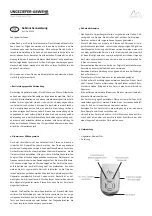
© National Instruments
|
5-9
You can route an internal or external periodic clock signal (with a known period) to the Source
input of the counter. The counter counts the number of rising (or falling) edges occurring on the
Source input between two edges of the Gate signal.
You can calculate the semi-period of the Gate input by multiplying the period of the Source
signal by the number of edges returned by the counter.
Refer to the following sections for more information about semi-period measurement options:
•
Single Semi-Period Measurement
•
Implicit Buffered Semi-Period Measurement
Refer to the
Pulse versus Semi-Period Measurements
section for information about the
differences between semi-period measurement and pulse measurement.
Single Semi-Period Measurement
Single semi-period measurement is equivalent to single pulse-width measurement.
Implicit Buffered Semi-Period Measurement
In implicit buffered semi-period measurements, on each edge of the Gate signal, the counter
stores the count in the FIFO. The STC3 transfers the sampled values to host memory using a
high-speed data stream.
The counter begins counting when it is armed. The arm usually occurs between edges on the
Gate input. You can select whether to read the first active low or active high semi period using
the
CI.SemiPeriod.StartingEdge
property in NI-DAQmx.
Figure 5-11 shows an example of an implicit buffered semi-period measurement.
Figure 5-11.
Implicit Buffered Semi-Period Measurement
For information about connecting counter signals, refer to the
section.
1
2
3
1
3
3
S
OURCE
GATE
Co
u
nter V
a
l
u
e
B
u
ffer
1
3
2
2
1
1
1
3
1
2
0
Co
u
nter
Armed
S
t
a
rting
Edge
















































